
North American Aerospace Defense Command, known until March 1981 as the North American Air Defense Command, is a combined organization of the United States and Canada that provides aerospace warning, air sovereignty, and protection for Canada and the continental United States.
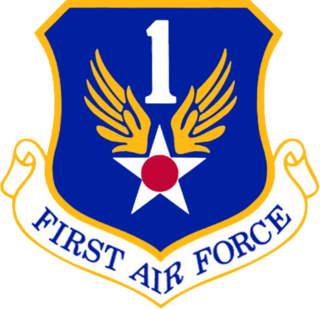
The First Air Force is a numbered air force of the United States Air Force Air Combat Command (ACC). It is headquartered at Tyndall Air Force Base, Florida. Its primary mission is the air defense of the Contiguous United States (CONUS), United States Virgin Islands and Puerto Rico. Since May 2022, it also provides the Air Force contribution to United States Space Command, as Air Forces Space (AFSPACE), including support functions for NASA human space flight.
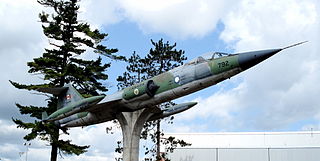
Canadian Forces Base Borden, formerly RCAF Station Camp Borden, is a large Canadian Forces base located in Ontario. The historic birthplace of the Royal Canadian Air Force, CFB Borden is home to the largest training wing in the Canadian Armed Forces. The base is run by Canadian Forces Support Training Group (CFSTG) and reports to the Canadian Defence Academy (CDA) in Kingston.
Ent Air Force Base was a United States Air Force base located in the Knob Hill neighborhood of Colorado Springs, Colorado. A tent city, established in 1943 during construction of the base, was initially commanded by Major General Uzal Girard Ent (1900–1948), for whom the base is named. The base was opened in 1951.

The Royal Canadian Air Force is the air and space force of Canada. Its role is to "provide the Canadian Forces with relevant, responsive and effective airpower". The RCAF is one of three environmental commands within the unified Canadian Armed Forces. As of 2020, the Royal Canadian Air Force consists of 12,074 Regular Force and 1,969 Primary Reserve personnel, supported by 1,518 civilians, and operates 258 manned aircraft and nine unmanned aerial vehicles. Lieutenant-General Eric Kenny is the current Commander of the Royal Canadian Air Force and Chief of the Air Force Staff.

The Eleventh Air Force (11 AF) is a Numbered Air Force of the United States Air Force Pacific Air Forces (PACAF). It is headquartered at Joint Base Elmendorf–Richardson, Alaska.

Canadian Forces Base Trenton, formerly RCAF Station Trenton, is a Canadian Forces base located within the city of Quinte West, Ontario. It is operated as an air force base by the Royal Canadian Air Force (RCAF) and is the hub for air transport operations in Canada and abroad. Its primary RCAF lodger unit is 8 Wing, commonly referred to as 8 Wing Trenton. CFB Trenton is Canada's largest Air Force base and most southerly air base.

Ralph Edward "Ed" Eberhart is a retired four-star general in the United States Air Force (USAF). He served as the commander of North American Aerospace Defense Command (NORAD) and United States Northern Command, Peterson Air Force Base, Colorado. He was in charge of NORAD during the September 11 attacks in 2001.
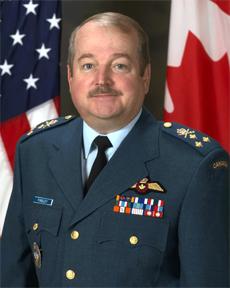
Lieutenant-General Eric A. "Rick" Findley, CMM, MSC, CD is a retired officer of the Canadian Forces Air Command and was the Deputy Commander of the North American Aerospace Defense Command (NORAD) from July 2003 through August 2007.
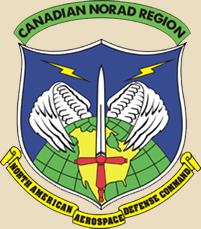
1 Canadian Air Division is the operational-level command and control formation of the Royal Canadian Air Force (RCAF). Prior to 2006 the official abbreviation for the division was 1 CAD. It is commanded by an air force major-general.
Operation Sky Shield, properly Exercise Sky Shield, was a series of three large-scale military exercises conducted in the United States and Canada in 1960, 1961, and 1962 by NORAD Command and CONAD Command to test defenses against an air attack from the Soviet Union. The tests were intended to ensure that any attacks over the American–Canadian border or coastlines would be detected and then stopped.

The 125th Fighter Wing is a unit of the Florida Air National Guard, stationed at Jacksonville Air National Guard Base, Florida. If activated to federal service with the United States Air Force, the 125 FW is operationally gained by the Air Combat Command (ACC).

William Evans "Bill" Gortney is a retired United States Navy admiral who served as the sixth commander of United States Northern Command and the 23rd commander of North American Aerospace Defense Command (NORAD). He previously served as the Commander, United States Fleet Forces Command from 14 September 2012 to December 2014 and Director of the Joint Staff from 1 July 2010 to August 2012. Prior to that, he served as Commander, U.S. Naval Forces Central Command/5th Fleet. He assumed his post as CDRUSNORTHCOM and commander of NORAD on 5 December 2014, and was succeeded by General Lori Robinson on 13 May 2016.

National Defence Headquarters (NDHQ) was created through the integration of the Canadian Armed Forces Headquarters with the civilian Department of National Defence (DND) staff in October of 1972. NDHQ is not a specific location, but is instead housed throughout a collection of offices in buildings across the National Capital Region, although it is most commonly identified with the Major-General George R. Pearkes Building on Colonel By Drive in Ottawa.

Seth Jefferson McKee was a United States Air Force general who served as Commander in Chief, North American Air Defense Command/Commander in Chief, Continental Air Defense Command from 1969 to 1973.

Lieutenant General Joseph Jacques Charles "Charlie" Bouchard is a retired Royal Canadian Air Force general. He has served as Commander of 1 Canadian Air Division / Canadian NORAD Region, the Deputy Commander of North American Aerospace Defense Command (NORAD) and Deputy Commander of Allied Joint Force Command Naples. On 25 March 2011, Bouchard was named Commander of the NATO military mission in Libya.

General Thomas James Lawson is a retired Royal Canadian Air Force general. Lawson was Chief of the Defence Staff of the Canadian Armed Forces from October 2012 to July 2015. He previously served as Deputy Commander of the North American Aerospace Defence Command.

Terrence John O'Shaughnessy is a retired United States Air Force four-star general who previously served as the commander of United States Northern Command and as the commander of North American Aerospace Defense Command.
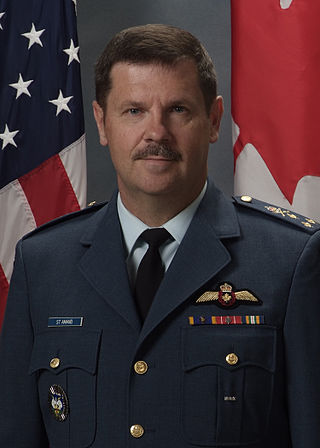
Joseph Pierre Julien St-Amand is a retired Royal Canadian Air Force Lieutenant-General. St-Amand served as deputy commander of North American Aerospace Defense Command and led its Canadian Element between 2015 and 2018. He previously commanded 441 Tactical Fighter Squadron, 4 Wing, and 1 Canadian Air Division, and was SHAPE Director of Strategic Planning between 2010 and 2011. During his tenure at SHAPE, St-Amand oversaw strategic planning for Operation Unified Protector.
This is the structure of the Royal Canadian Air Force, as of November 2020.

















